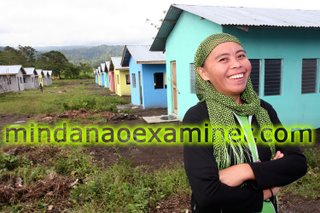 A Gawad Kalinga Village volunteer teacher, Kat Hakim, smiles as she welcomes visitors; behind her a row of houses donated by Smart Communications Inc., in the former Moro rebel base, now a sprawling Muslim community in Barira town in Maguindanao province. (Mindanao Examiner)
A Gawad Kalinga Village volunteer teacher, Kat Hakim, smiles as she welcomes visitors; behind her a row of houses donated by Smart Communications Inc., in the former Moro rebel base, now a sprawling Muslim community in Barira town in Maguindanao province. (Mindanao Examiner)MAGUINDANAO (Mindanao Examiner / 22 Oct) – For the country's leading cellular carrier, contributing to Gawad Kalinga's much-awarded community-building program is not just about building homes.
Smart Communications, Inc. (Smart) is also engaged in helping develop innovative entrepreneurial projects and disaster preparedness programs for its beneficiaries.
More than two years since it pledged to build its first Gawad Kalinga (GK) village for fire victims of Baseco Compound in Tondo district in Manila, the cellular giant, together with parent firm, Philippine Long Distance Telephone Co. (PLDT), has committed to build at least 7 GK Amazing Villages for homeless families displaced by various calamities.
At 100 per village, Smart committed to construct 700 new houses. "As we build these communities, we are also adding livelihood and disaster preparedness projects. These elements are needed to help make these communities sustainable," said Ramon R. Isberto, Public Affairs Group head of SMART, at a recent forum in Manila.
Called "Rising from Disaster... Beyond Relief,” the forum was held during the three-day Gawad Kalinga Global Expo 2006 at SM Mall of Asia in Manila. The forum was one of many activities that were part of the themed “The Power of We,” to mark Gawad Kalinga (GK) Foundation's GK 777 3rd year anniversary.
Through GK 777, the Couples for Christ-based foundation aims to provide 700,000 homes in 7,000 communities in seven years or by 2010.
Smart and PLDT have completed two villages - in Baseco Compound and in the former Moro rebel base Camp Abubakar in Maguindanao province, now a sprawling community of hundreds of Muslim families, mostly members of the Iranun tribe who lost their homes during the armed conflict several years ago.
Four villages are also expected to be completed by next year, in General Nakar in Quezon province or victims of floods and landslides; Cebu City for informal settlers; Iloilo City for families of street children; and Fort Magsaysay in Laur town in Nueva Ecija, for families of members of the Armed Forces of the Philippines.
PLDT, Smart, GK and the local government are preparing for the seventh village in Southern Leyte in central Philippines and will benefit mostly survivors of landslide that buried the village of Guinsaugon in February.
"This year, we are consolidating our seven GK villages and are focusing on livelihood and disaster preparedness to make sure that people will be safe and secure," said Isberto.
The Smart Amazing GK Village in the village of Banglos in General Nakar, Quezon showcases Smart's evolving approach to community building. Aside from providing the funds to build 100 houses for flood and mudslide victims, Smart has deployed more than 600 employees who volunteered to help in the actual construction of houses.
Smart has also helped the Banglos residents develop an innovative livelihood project by turning the old logs washed down by the floods into wood sculpture. Some 40 Banglos residents, who are mostly farmers and fishermen, learned the art of wood sculpting from renowned sculptor Rey Paz Contreras.
"While they go on with their livelihood, now, they're also artists in their own right," said Darwin Flores, Smart's senior manager for Community Partnerships. The company also engaged the environmental group Haribon Foundation to assist Banglos residents in replanting 20,000 wildlings in the surrounding areas, Isberto added.
Following the recommendation of the Department of Environment and Natural Resources (DENR, endemic species or plants that are native to General Nakar, have been planted.
Smart has also set up an emergency communications system in the towns of Real, Infanta and General Nakar in Quezon under the Reina project of the Philippine Institute of Volcanology and Seismology (Phivolcs).
It donated “batingaws” or warning bells made from recycled oxygen tanks to warn residents should there be a need for mass evacuation from flashfloods or other calamities. When disaster strikes, emergency teams warn villages and then the local officials use the batingaw to assemble the residents.
"The response of national and regional authorities during calamities is not enough," said Isberto. "Communities also need to know what to do. So, community-based disaster programs are essential," he said. (Mindanao Examiner)
1 comment:
What's the good thing about Gawad Kalinga is that there are now numbers of national leaders and politicians who take part on the program and are all advocates of the Gawad Kalinga's vision. There will be also a Gawad Kalinga Global Summit will be held at Boston. Gawad Kalinga aims to eradicate homelessness, hunger, and poverty for the millions of impoverished Filipino families all over the Philippines.
Post a Comment